|
|
|
|
 |
BIRDS: Pigeons, Rock Doves |
|
|
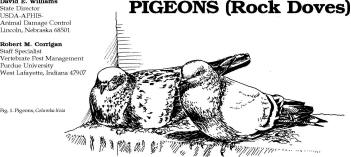
Identification
Pigeons (Columba livia)
typically have a gray body with a whitish rump, two
black bars on the secondary wing feathers, a broad black
band on the tail, and red feet (Fig. 1). Body color can
vary from gray to white, tan, and black. The average
weight is 13 ounces (369 g) and the average length is 11
inches (28 cm). When pigeons take off, their wing tips
touch, making a characteristic clicking sound. When they
glide, their wings are raised at an angle.
Range
Pigeons are found
throughout the United States (including Hawaii),
southern Canada, and Mexico.
Habitat
Pigeons are highly
dependent on humans to provide them with food and sites
for roosting, loafing, and nesting. They are commonly
found around farm yards, grain elevators, feed mills,
parks, city buildings, bridges, and other structures.
Food Habits
Pigeons are primarily
grain and seed eaters and will subsist on spilled or
improperly stored grain. They also will feed on garbage,
livestock manure, insects, or other food materials
provided for them intentionally or unintentionally by
people. In fact, in some urban areas the feeding of
pigeons is considered a form of recreation. They require
about 1 ounce (30 ml) of water daily. They rely mostly
on free-stand-ing water but they can also use snow to
obtain water.
General Biology, Reproduction, and Behavior
The common pigeon was
introduced into the United States as a domesticated
bird, but many escaped and formed feral populations. The
pigeon is now the most common bird pest associated with
people.
Pigeons inhabit lofts,
steeples, attics, caves, and ornate architectural
features of buildings where openings allow for roosting,
loafing, and nest building. Nests consist of sticks,
twigs, and grasses clumped together to form a crude
platform.
Pigeons are monogamous.
Eight to 12 days after mating, the females lay 1 or 2
eggs which hatch after 18 days. The male provides
nesting material and guards the female and the nest. The
young are fed pigeon milk, a liquid-solid substance
secreted in the crop of the adult (both male and female)
that is regurgitated. The young leave the nest at 4 to 6
weeks of age. More eggs are laid before the first clutch
leaves the nest. Breeding may occur at all seasons, but
peak reproduction occurs in the spring and fall. A
population of pigeons usually consists of equal numbers
of males and females.
In captivity, pigeons
commonly live up to 15 years and sometimes longer. In
urban populations, however, pigeons seldom live more
than 3 or 4 years. Natural mortality factors, such as
predation by mammals and other birds, diseases, and
stress due to lack of food and water, reduce pigeon
populations by approximately 30% annually.
Damage
Pigeon droppings deface
and accelerate the deterioration of buildings and
increase the cost of maintenance. Large amounts of
droppings may kill vegetation and produce an
objectionable odor. Pigeon manure deposited on park
benches, statues, cars, and unwary pedestrians is
aesthetically displeasing. Around grain handling
facilities, pigeons consume and contaminate large
quantities of food destined for human or livestock
consumption.
Pigeons may carry and
spread diseases to people and livestock through their
droppings. They are known to carry or transmit pigeon
ornithosis, encephalitis, Newcastle disease,
cryptococcosis, toxoplasmosis, salmonella food
poisoning, and several other diseases. Additionally,
under the right conditions pigeon manure may harbor
airborne spores of the causal agent of histoplasmosis, a
systemic fungus disease that can infect humans.
The ectoparasites of
pigeons include various species of fleas, lice, mites,
ticks, and other biting insects, some of which readily
bite people. Some insects that inhabit the nests of
pigeons are also fabric pests and/or pantry pests. The
northern fowl mite found on pigeons is an important
poultry pest.
Pigeons located around
airports can also be a threat to human safety because of
potential bird-aircraft collisions, and are considered a
medium priority hazard to jet aircraft by the US Air
Force.
Legal Status
Feral pigeons are not
protected by federal law and most states do not afford
them protection. State and local laws should be
consulted, however, before any control measures are
taken. Some cities are considered bird sanctuaries that
provide protection to all species of birds.
Damage Prevention and Control Methods
Habitat Modification
Elimination of feeding, watering, roosting, and
nesting sites is important in long-term pigeon control.
Discourage people from feeding pigeons in public areas
and clean up spilled grain around elevators, feed mills,
and railcar clean-out areas. Eliminate pools of standing
water that pigeons use for watering. Modify structures,
buildings, and architectural designs to make them less
attractive to pigeons.
Exclusion
Pigeons can be
excluded from buildings (in some cases very easily) by
blocking access to indoor roosts and nesting areas.
Openings to lofts, steeples, vents, and eaves should be
blocked with wood, metal, glass, masonry, 1/4-inch
(0.6-cm) rustproofed wire mesh, or plastic or nylon
netting.
Roosting on ledges can be
discouraged by changing the angle to 45o or more. Sheet
metal, wood, styrofoam blocks, stone, and other
materials can be formed and fastened to ledges to
accomplish the desired angle. Ornamental architecture
can be screened with 1-inch (2.5-cm) mesh polypropylene
u.v.-stabilized netting to prevent roosting, loafing,
and nesting. To make the netting aesthetically pleasing,
it can be spray painted to match the color of the
building, but black is often the best choice. The life
span of this netting can be as long as 10 years.
In a tool or machinery
shed, barn, hangar, or other similar buildings, roosting
can be permanently prevented by screening the underside
of the rafter area with netting. Nylon netting can be
stapled or otherwise affixed to the underside of rafters
to exclude birds from nesting and roosting. Panels can
be cut into the netting and velcro fasteners can allow
access to the rafter area to service equipment or
lights.
Porcupine wires (Cat
ClawTM, NixaliteTM) are mechanical repellents that can
be used to exclude pigeons. They are composed of a
myriad of spring-tempered nickel stainless steel prongs
with sharp points extending outward at all angles. The
sharp points of these wires inflict temporary discomfort
and deter pigeons from landing on these surfaces. The
prongs are fastened to a solid base that can be
installed on window sills, ledges, eaves, roof peaks,
ornamental architecture, or wherever pigeons are prone
to roost (Fig. 2). Elevate the base with plastic washers
and anchor it with electrical bundle straps. Sometimes
pigeons and sparrows cover the wires with nesting
material or droppings, which requires occasional
removal.
A variation of porcupine
wires, ECOPICTM, mounts flat to a surface and has a
triangular pattern of vertically oriented stainless
steel rods.
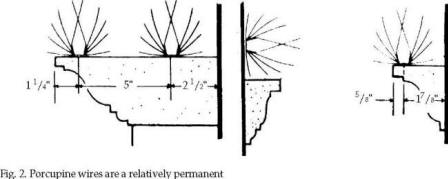
Bird Barrier is another
permanent nonlethal mechanical repellent used to exclude
pigeons from structures. It is a stainless steel coil
affixed to a base-mounting strip that can be attached to
structural features as one would with porcupine wires.
Tightly stretched parallel
strands of 16to 18-gauge steel wire or 80-pound+
(36-kg+) test monofilament line can be used to keep
birds off support cables, narrow ledges, conduit, and
similar areas. Attach L-brackets at each end of the area
or item to be protected and fasten the wire to the
L-brackets with turnbuckles. Slack is taken out using
the turnbuckles. L-brackets should be welded or attached
with a cable clamp or aircraft hose clamps (threads on
standard radiator clamps become stripped under the high
torque loads required for holding L-brackets supporting
wire over long distances). On heavily used structures,
it may be necessary to stretch 3 lines at 2, 5, and 7
inches (5, 12, and 18 cm) above the surface.
Overhead monofilament grid
systems, 1 x 1 foot to 2 x 2 feet (30 x 30 cm to 60 x 60
cm), have been used successfully to reducing pigeon
activity in enclosed courtyards. Persistent pigeons will
likely penetrate parallel or grid-wire (line) systems.
Electric shock bird
control systems (Avi-AwayTM, FlyawayTM, and Vertebrate
Repellent System [VRSTM]) are available for repelling
many species of birds, including pigeons. The systems
consist of a cable durably embedded in plastic with two
electrical conductors. Mounting and grounding hardware
and a control unit are included. The conductors carry a
pulsating electric charge. When pigeons make contact
with the conductors and the cable, they receive a shock
that repels but does not kill them. The cable can be
installed in situations also suitable for porcupine
wires and stretched steel wires or monofilament lines.
Although these devices and their installation are
usually labor intensive and/or expensive, their
effectiveness in some cases justifies the investment.
These devices have a life span of 8 years on residential
structures.
Frightening
Noise-making
devices are usually disturbing to humans but have little
permanent effect on roosting pigeons. High-frequency
(ultrasonic) sound, inaudible to humans, is not
effective on pigeons. Revolving lights, waving colored
flags, balloons, rubber snakes, owl models, and other
devices likewise have little or no effect. Roman
candles, firecrackers, and other pyrotechnics may have a
temporary effect but have many limitations in use and
often fail to provide long-term control, especially
against pigeons.
Nesting sites can be
sprayed with streams of water to disperse pigeons, but
this must be done persistently until the birds have
established themselves elsewhere.
Avitrol®
(4-aminopyridine).
Avitrol® is
classified as a chemical frightening agent, but it can
be used as a toxicant in areas where higher mortality is
acceptable. Blend ratios of 1:9 will produce higher
mortality than more dilute applications. See the section
on Toxicants in this chapter for information on
prebaiting and baiting.
Avitrol® for pigeon
control is a whole-corn bait formulated with
4-aminopyridine, a Restricted Use Pesticide and may be
used only by a certified applicator or persons under
their direct supervision. Birds that consume sufficient
amounts of the treated bait usually die. The dying birds
exhibit distress behavior that frightens other members
of the flock away. In order to minimize the mortality
and maximize the flock-alarming reactions, the treated
bait must be diluted with clean, untreated whole corn.
In urban areas where high
bird mortality may cause adverse public reactions, a
blend ratio of 1:19 or 1:29 will produce low mortality,
but requires more time to achieve control. Where high
mortality is acceptable, a blend ratio of 1:9 will
produce quicker population reduction. Prebaiting for at
least 10 to 14 days is critical for a successful
program. At the conclusion of the program, all
unconsumed bait should be recovered to prevent nontarget
birds from ingesting the bait.
Secondary poisoning is
unlikely to occur with Avitrol®, although it is toxic to
any bird through direct ingestion. Avitrol® is designed
to be as selective as possible but should always be used
to minimize the possibility that nontarget species will
have access to the bait. After initial success, Avitrol®
need only be applied periodically following prebaiting
to maintain effective control.
Repellents
Various
nontoxic chemical repellents (polybutenes) such as 4 The
BirdsTM, HotfootTM, TanglefootTM, Roost No MoreTM, and
Bird-ProofTM, are available in the form of liquids,
aerosols, nondrying films, and pastes. These substances
are not toxic to pigeons. Rather, they produce a sticky
surface that the pigeons dislike, forcing them to find
loafing or roosting sites elsewhere.
Building surfaces should
first be cleaned and protected with a waterproof tape
before applying the repellent. Otherwise, sticky
repellents may be difficult to remove or may stain the
building.
Applications should be
made about 1/2 inch (1.3 cm) thick in rows spaced no
farther than 3 to 4 inches (7.6 to 10.2 cm) apart.
Pigeons should not be able to land between the rows
without contacting the repellent. To be effective, all
roosting and/or loafing surfaces in a problem area must
be treated, or the pigeons will move to untreated
surfaces.
The effectiveness of
sticky repellents is usually lost over time, especially
in dusty areas. An application may remain effective for
6 months to 2 years. Some manufacturers have added a
protective second-stage application that forms a crust
on the repellent and helps extend the life of the
repellent in dusty or hot areas. Some pest control
operators spray clear shellac over the applied repellent
to accomplish the same affect.
Although chemical
repellents offer effective results in many situations,
there are several important considerations. First,
repellents are not aesthetically pleasing. Second, they
can be annoying to professional window cleaners in urban
areas. Third, nesting pigeons will occasionally drop
sticks and straw over the repellents and continue to
nest. Fourth, high temperatures may cause the material
to run down the sides of buildings, while cold
temperatures may cause the repellent to become too stiff
for the bird’s feet to penetrate. Finally, chemical
repellents are most appropriate for small- and
medium-sized jobs. For large commercial situations
requiring significant amounts of labor and expensive
equipment, the use of repellents may be economically
shortsighted because they are expensive to reapply
frequently.
Naphthalene is a repellent
that may offend the bird’s olfactory sense. Naphthalene
flakes are federally registered as a repellent for
pigeons, though they are not registered in every state.
Upon evaporation, naphthalene produces a strong odor
that repels pigeons from enclosed areas such as attics
and wall voids. The flakes are spread on the attic floor
or between walls, using about 5 pounds (2.3 kg) for
every 2,000 cubic feet (56 cu. m) of space. After the
birds have departed, all openings must be closed to
prevent reentry. The strong odor produced by naphthalene
flakes is also disagreeable and irritating to some
people. Prolonged breathing of the vapor should be
avoided.
Toxicants
Pigeon control
using toxicants may require special permits issued
through various state agencies such as state departments
of agriculture, health, or wildlife.
Toxic Baits
Prebaiting.
Prebaiting is the single most important element of a
successful toxicant program. The birds must be trained
to feed on a specific bait at specific sites before the
toxicant is introduced. If the prebaiting is not done
correctly, the results will likely be less than
desirable.
Before any control work is
attempted, the daily movement patterns of the birds
between feeding, loafing, and roosting areas must be
determined. Several potential baiting sites can then be
selected. The number of bait sites selected depends on
the size of the area being treated and the number of
birds involved, but if possible, three to five baiting
sites should be used. Establish bait sites in locations
normally frequented by the birds, free from
disturbances, and where rigid control over access can be
maintained at all times. Generally, the closer the bait
site is to the normal feeding site, the more successful
the program.
In urban areas, flat
rooftops make excellent bait sites, even though pigeons
do not normally feed on them. They do normally frequent
rooftops, however, and it is possible to control access
to them. With persistence, pigeons can be trained to
feed almost anywhere.
Every effort must be made
to reduce or eliminate food sources other than the
prebait so that pigeons will have to rely solely on the
prebait. It must be as nearly identical to the toxic
bait as possible. Generally, the best prebait and bait
is clean, untreated whole corn. Whole corn is
recommended because smaller resident birds, such as
sparrows, are physically incapable of swallowing it,
thus reducing the possibility of poisoning these birds.
Also, corn is a high-energy food and is therefore
preferred by pigeons, especially during the winter
months. A constant supply of fresh, acceptable prebait
must be made available to the birds at all times. There
should always be a little prebait left over when the
birds finish feeding. It is impossible to train birds to
feed at a site where they cannot get enough to eat.
Therefore, all birds must have the opportunity to feed
or they will simply go elsewhere. Once the pigeons have
been trained to feed at the selected locations, the
toxic bait may be applied.
Prebaiting and subsequent
toxic baiting should be done at the same time of day and
in the same manner. Pigeons usually feed most vigorously
shortly after leaving the roost early in the morning.
Therefore, prebait and bait should be placed before
dawn. The duration of the prebaiting period will vary as
each case is different. Usually, 2 weeks of prebaiting
is most effective.
Apply the prebait on firm,
relatively smooth surfaces, or on wide, shallow wooden
or metal trays. This helps the applicator maintain
control of the prebait and poison bait, and will
facilitate the removal of any unused material at the end
of the control program. Record the quantity of prebait
placed and consumed each day so that the correct amount
of treated bait to be used can be determined. Generally,
100 feeding pigeons will eat about 7 to 8 pounds (15 to
18 kg) of whole corn per day.
The prebait and toxic bait
should be placed in numerous small piles so that all
birds can feed at one time. Never place the prebait or
toxic bait in one pile. For large flocks (100 birds or
greater), 8 to 12 piles containing 1 pound (454 g) of
grain each may be necessary. Small flocks of less than
100 birds can be accommodated with three to four piles.
During the prebaiting
period, the site must be carefully observed to ensure
that the prebait is not attracting nontarget birds such
as cardinals, blue jays, or doves. If protected birds
appear at a bait site, continue to put out the prebait
to keep the protected birds there while toxic baits are
put out elsewhere. Do not place toxic baits at sites
used by nontarget birds. If protected birds begin using
all the locations, new bait sites will have to be
established or the plan to use toxic baits abandoned.
Poisoning birds is a
complex task that requires careful attention to details.
Do not take shortcuts, especially in prebaiting.
Baiting and Baits
All prebait
must be removed before the toxic bait is applied. When
the toxic bait is put out, the feeding birds should not
be disturbed but should be observed from a hidden
location.
DRC-1339
(3-chloro-p-toluidine hydrochloride). DRC-1339 is a
Restricted Use Pesticide registered for the control of
pigeons. It can only be used by USDA-APHIS-ADC employees
or persons working under their direct supervision.
The toxicity of DRC-1339
to birds varies considerably. Starlings, red-winged
blackbirds, crows, and pigeons are most susceptible, but
house sparrows and hawks are somewhat resistant.
Therefore, DRC-1339 may be a toxicant that provides a
higher margin of safety than the other toxicants for use
in cities where peregrine falcons have been introduced.
Generally, mammals are not sensitive to the toxic
effects of DRC-1339.
DRC-1339 is slow-acting
and apparently painless. It takes from several hours to
3 days for death to occur. Death is caused by uremic
poisoning and occurs without convulsions or spasms as in
the case of other toxicants. DRC-1339 is metabolized
within 2 1/2 hours after ingestion. Normally, there is
little chance of undigested bait remaining in the crop
or gut of dead or dying pigeon. The excreta and the
flesh of pigeons poisoned with DRC1339 are nontoxic to
predators or scavengers.
Because of the slow rate
of death, the majority of dead birds are usually found
at the roost site. Since bait shyness does not develop,
DRC-1339 allows for baiting programs to be extended
until control is achieved. Areas where pigeons roost or
loaf should be monitored so that carcasses can be picked
up.
As in other baiting
programs, prebaiting is critical to successful control.
Prebaits and carriers for toxic baits can be made from
one of the following: oat groats, cracked corn, whole
corn, commercial wild bird seed, or commercial poultry
mix. A good technique is to use more than one type of
prebait, in order to assess which is better accepted by
the target population.
Do not bait sites where
prebait has not been accepted well or where nontarget
species have been consuming prebait.
Contact Poisons
The Rid-A-BirdTM
perch contains 11% fenthion, a Restricted Use Pesticide,
and is registered for pigeon control. These perches are
hollow tubes that hold about 1 ounce (28 ml) of the
toxicant within a wick. When a bird lands on the perch,
the toxicant is absorbed through the feet in a short
period of time. Death usually takes place within 24 to
72 hours. Pigeons may die at the roost site or some
distance away if contact was made at a feeding or
loafing area.
Perches are available in a
number of configurations for both indoor and limited
outdoor applications. The wide perch, 1 x 24 inches (2.5
x 61 cm), is used to accommodate the sitting (nongrasping)
habit of pigeons (Fig. 3). Ten to 12 perches will solve
most problems, but large jobs may require as many as 30
perches. For example, in a warehouse measuring 50 x 100
feet (15 x 30 m), most pigeons can be eliminated by
placing one or two perches in each heavily used area.
Effective places to install perches around struc-tures
can be determined if the area is observed for preferred
perching areas for 48 hours before placement.
Toxic perches should be
used only by persons experienced with their usebecause
they can be hazardous to other birds, animals, and
people if used incorrectly. Label instructions must be
rigidly followed.
Fenthion may present a
secondary hazard to birds of prey, small carnivores, and
scavengers. Any nontarget animals, including humans,
that come in contact with the perch itself could absorb
a fatal amount of fenthion. Trapping Pigeons can be
effectively controlled by capturing them in traps placed
near their roosting, loafing, or feeding sites. Some
traps, such as the common pigeon trap (Fig. 4), are over
6 feet (2 m) tall, while low-profile traps (Fig. 5)
measure only 9 inches (23 cm) high and 24 inches (61 cm)
in width and length. Generally, the larger the
population of birds to be trapped, the larger the trap
should be. Although larger traps hold many birds, they
can be cumbersome in situations such as rooftop trapping
programs. In these instances, it may be more convenient
to use several low-profile traps that are more portable
and easier to deploy. Small portable traps, such as the
funnel trap or the lily-pad trap (Fig. 6), can be easily
constructed and deployed. Live traps and/or trap parts
designed for the capture of small birds are also
commercially available (see Supplies and Materials).
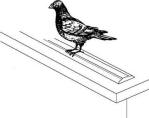
Fig. 3 Rid-A-BirdTM perch for pigeons.
Trapping
Tips for
Effective Trapping. The best locations for traps are
major pigeon loafing areas. During the heat of the
summer, place traps near pigeonwatering sites such as
rooftop cooling condensers. Also consider prebaiting
areas for several days before beginning the actual
trapping. To prebait, place attractive baits,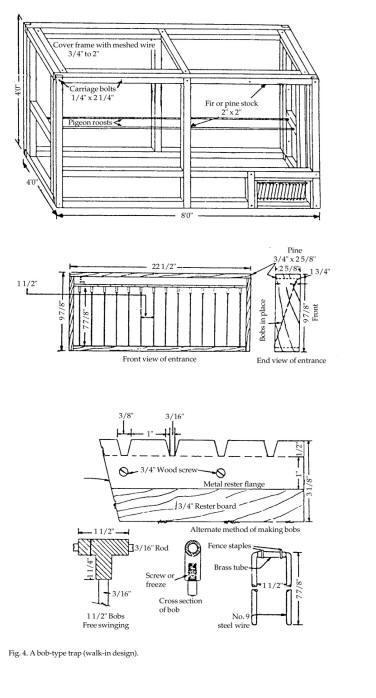 such as corn or milo, around the outside of the traps.
After 3 to 4 days, the baits can be placed inside the
trap (in both compartments of the low-profile trap).
Four or five decoy birds should be left in the trap to
lure in more pigeons.
such as corn or milo, around the outside of the traps.
After 3 to 4 days, the baits can be placed inside the
trap (in both compartments of the low-profile trap).
Four or five decoy birds should be left in the trap to
lure in more pigeons.
Visit traps at least every
other day. Fresh food and water must be provided at all
times for decoy birds. If “trap-shyness” develops, traps
can be left open for 2 to 3 days and then reset again
for 4 to 5 days. Select another site if traps fail to
catch a sufficient number of birds. The disposal of
trapped birds should be quick and humane. The act of
inducing painless death is called euthanasia. There are
several options to select from, including inhalant
agents, noninhalant pharmacologic agents, and physical
methods. Review the 1986 report of the American
Veterinary Medical Association panel on euthanasia when
selecting a humane disposal method.
For large-scale pigeon
control projects, the most cost-effective and humane
method is to use a carbon monoxide (CO) or carbon
dioxide (CO2) gas chamber. These chambers utilize
commercially available compressed CO or CO2 in gas
cylinders. The chambers can be purchased commercially or
be constructed by modifying a garbage can or 55 gallon
(209 l) drum with a tight-fitting lid having a hole for
a gas supply line. Birds will expire in 5 to 7 minutes
(using CO or CO2), when the gas flow displaces
approximately 20% of the chamber volume per minute.
Chambers should be used in well-ventilated areas,
preferably outside, to protect personnel.
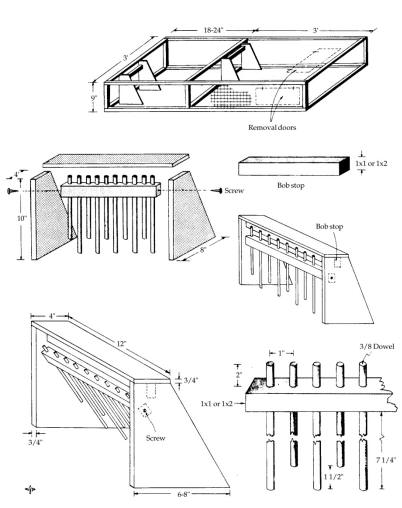
Fig. 5. A bob-type trap (low-profile design).
Fig. 6. (a) Lily-pad trap
and clover-leaf trap; (b) double funnel trap.
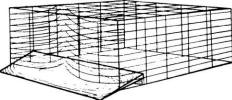
Double Funnel Trap
Releasing pigeons back to
the “wild” is impractical. Pigeons are likely to return
even when released 50 or more miles (>80 km) from the
problem site, or become pests in other communities.
Cannon Nets.
A cannon net may be effective and practical where
pigeons congregate in large numbers on the ground (for
instance, rail yards and grain-handling facilities).
Cannon nets are large sections of netting attached to
explosive charges that are activated when birds are
within range. They can be set up adjacent to areas where
pigeons visit on a daily basis to feed. The net operator
observes from a hidden location and activates the
explosive propellent with an electrical charge. The
netting travels over the birds, then drops on the flock.
Cannon nets can capture up to 500 birds at a time.
Shooting
Where
permissible, persistent shooting with .22 caliber rifles
(preferably using ammunition loaded with short-range
pellets), .410 gauge shotguns, or high-powered air
rifles can eliminate a small flock of pigeons. For
example, shooting can be an effective technique to
remove the few pigeons that may persist around farm or
grain elevators after a reduction program has been
terminated.
Most towns and cities have
ordinances prohibiting the discharge of firearms within
corporate limits. Check local laws before employing a
shooting program.
Other Control Methods
Alpha-chloralose. Alpha-chloralose is an immobilizing
agent that depresses the cortical centers of the brain.
Pigeons fed about 60 mg/kg of alpha-chloralose become
comatose in 45 to 90 minutes. The pigeons can then be
captured to be relocated or euthanized. Full recovery
occurs 4 to 24 hours later.
The Food and Drug
Administration (FDA) has granted USDA-APHIS-ADC
authority to use alpha-chloralose to capture pigeons
under a perpetual Investigational New Animal Drug
Application (INADA). The INADA is the only legal way to
use alpha-chloralose as a wildlife immobilizing agent.
The drug can be legally obtained for this use only from
the Pocatello Supply Depot. Only USDA-APHIS-ADC
personnel certified in its use or individuals under
their supervision are allowed to use alpha-chloralose.
Nest Destruction
Destroying nests and eggs at 2-week intervals can be
helpful in reducing pigeon numbers. This technique,
however, should be used in conjunction with other
control methods.
Economics of Damage and Control
Structures inhabited by
pigeons can sustain damage from droppings and harbor
disease. The droppings can also make structural surfaces
slick and hazardous to walk or climb on.
Washing acidic
accumulations of droppings to prevent structural damage
can cost in excess of $10,000 per year. The longevity of
industrial roofing materials can be adversely affected
by droppings, resulting in expensive replacement costs.
Employee health claims and
lawsuits resulting from diseases or injuries attributed
to pigeons can easily exceed $100,000.
An integrated pigeon
management program incorporating lethal and nonlethal
control techniques is well worth the investment when
considering the economic damage and health threats
caused by large populations of pigeons.
Acknowledgments
Special thanks go to Mr.
Fred Courtsal, retired USDA-APHIS-ADC state director,
for his work in compiling the original chapter on pigeon
control. Many ADC field personnel provided valuable
input regarding updates and revisions on pigeon control.
We would also like to thank Kathleen LeMaster and Dee
Anne Gillespie, who coordinated revisionary corrections.
Figure 1 by Emily Oseas
Routman.
Figure 2 courtesy of
Nixalite Company of America.
Figure 3 by Renee Lanik,
University of Nebraska-Lincoln.
Figures 4, 5, and 6 from
US Fish and Wildlife Service (1961), Trapping Pigeons,
Leaflet AC 206, Purdue University, West Lafayette,
Indiana.
For Additional Information
American Veterinary
Medical Association. 1986. Report of the American
Veterinary Medical Association panel on euthanasia. J.
Amer. Veterin. Med. Assoc. 188(3):252-268.
Bennett, G. W., J. M.
Owens, and R. M. Corrigan. 1989. Pigeon control. Pages
333-336 in Truman’s scientific guide to pest control
operations. Purdue Univ./Edgell Commun. Duluth,
Minnesota. 539 pp.
Corrigan, R. M. 1989. A
guide to managing pigeons and sparrows. Pest Control
Tech.17(1):38-40, 44-46, 48-50.
Corrigan, R. M., D. E.
Williams, and F. Courtsal. 1989. Pigeons, ADC-1. Coop.
Ext. Serv. Purdue Univ. West Lafayette, Indiana. 6 pp.
Department of the
Interior, US Fish and Wildlife Service. 1961. Trapping
pigeons, ADC-206. Coop. Ext. Serv. Purdue Univ., West
Lafayette, Indiana. 2 pp.
Jackson, W. B. 1978.
Rid-A-BirdTM perches to control bird damage. Proc.
Vertebr. Pest Conf. 8:47-50.
Marsh, R. E., and W. E.
Howard. 1990. Vertebrate pests. Pages 771-832 in A.
Mallis, ed., Handbook of pest control. 7th ed. Franzak
and Foster Co., Cleveland, Ohio.
Martin, C., and L. R.
Martin. 1982. Pigeon control: an integrated approach.
Proc. Vertebr. Pest Conf. 10:190-192.
Murton, R. K., R. J. P.
Thearle, and J. Thompson. 1972. Ecological studies of
the feral pigeon, Columba livia var. J. Appl. Ecol.
9:835-874.
Scott, H. G. 1961.
Pigeons, public health importance and control. Commun.
Disease Center. Atlanta, Georgia. 17 pp.
Weber, W. J. 1979. Health
hazards from pigeons, starlings and English sparrows.
Thomson Pub., Fresno, California, 138 pp.
Woronecki, P. P. 1988.
Effect of ultrasonic, visual and sonic devices on pigeon
numbers in a vacant building. Proc. Vertebr. Pest Conf.
13:266-272.
Editors
Scott E. Hygnstrom Robert
M. Timm Gary E. Larson
PREVENTION AND CONTROL OF
WILDLIFE DAMAGE — 1994
Cooperative Extension
Division Institute of Agriculture and Natural Resources
University of Nebraska -Lincoln
United States Department
of Agriculture Animal and Plant Health Inspection
Service Animal Damage Control
Great Plains Agricultural
Council Wildlife Committee
01/09/2007
Special
thanks to:
Clemson University
|